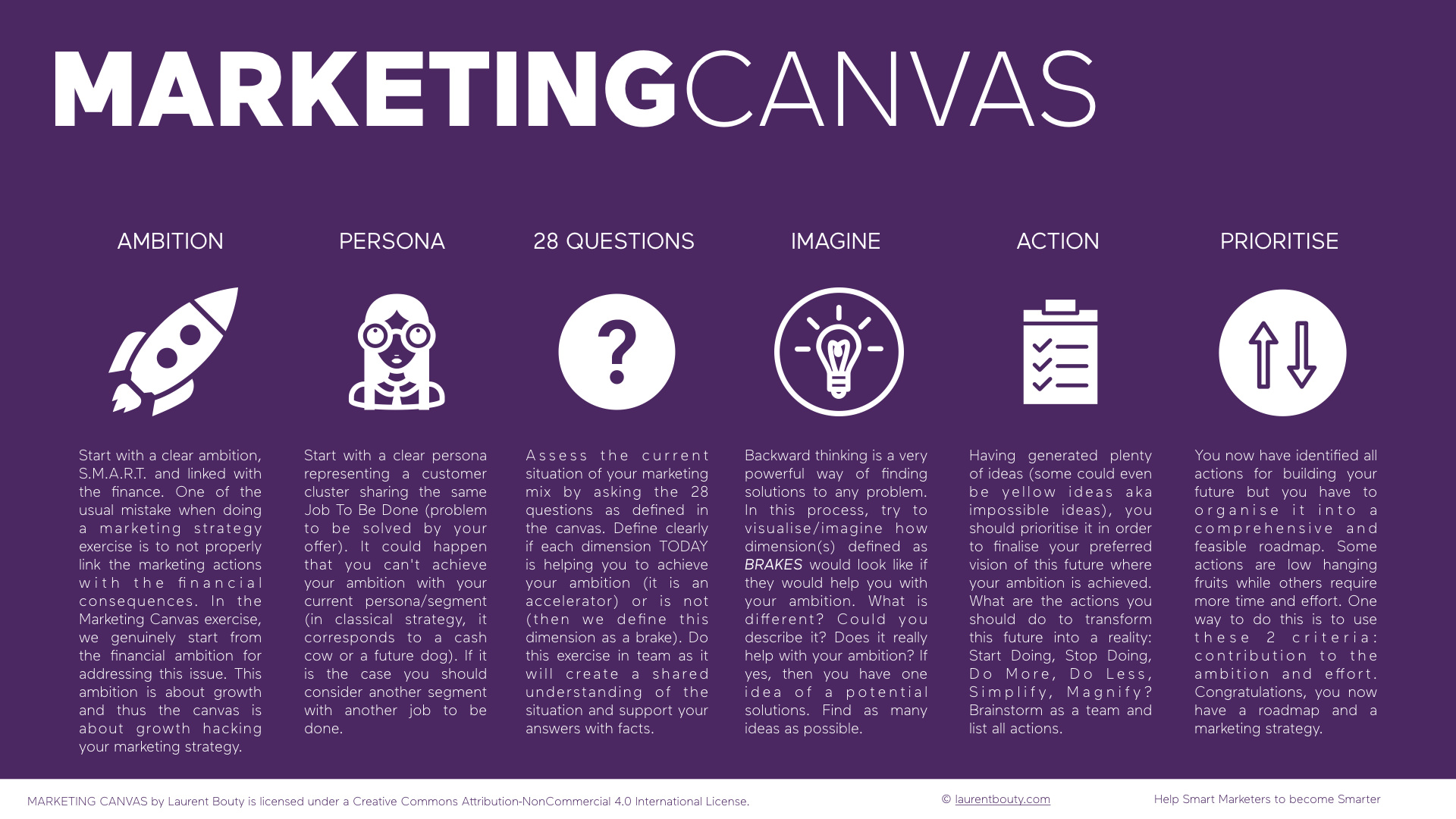Defining your market and identifying the key benefits that matter to customers are foundational steps in building a competitive strategy. Knowing where your product or service fits ensures clarity about your audience and competitors, while understanding customer benefits—both functional and emotional—reveals opportunities for differentiation.
Marketing Canvas - Step 1 - Market Assessment
Marketing Canvas - Define your financial hypothesis
When working with the Marketing Canvas, It is important to formulate your financial goal(s) as an hypothesis (Step 2). The assessment that will be done afterwards (Step 3) is measuring your ability to reach this goal without changing your current strategy. It is therefore highly important that you clarify your hypotheses
Attention Economy
Marketing Canvas and Customers
When working on the Customers part of the Marketing Canvas, you are trying to identify relevant and actionable triggers (you can also call it insights) that you will try to leverage through the other dimensions of the canvas. We have 4 dimensions you can play with for identifying these triggers (JTBD, ASPIRATIONS, PAINS & GAINS, ENGAGEMENT).
Marketing Canvas - Step 2 - Set Your Goals
Marketing Canvas - Influencers
Marketing Canvas - Pricing
Marketing Canvas - Visual Identity
Our article delves into the integral role of Visual Identity, a critical sub-dimension of the Marketing Canvas developed by Laurent Bouty. We begin with defining visual identity, as conceived by eminent industry figures like David Aaker and Jeff Bezos, and explain how it goes beyond merely a logo or graphic design. Exploring connections to other sub-dimensions such as Purpose, Positioning, and Values, we highlight its overall impact on your brand's strength. We break down the assessment process into a robust scoring system, identifying potential reasons for various scores and recommending improvement strategies tailored to each scenario. By synthesizing theory with real-world applications, this article offers valuable insights for anyone keen to strengthen their brand's visual identity. Whether you're a seasoned marketer, budding entrepreneur, or simply interested in understanding branding better, our guide aims to make the complex concept of visual identity easy to grasp and apply.
Marketing Canvas - Positioning
Marketing Canvas - Purpose
The Marketing Canvas is a tool to build a marketing strategy that consists of six categories, including PURPOSE, which identifies a brand's reason for being and contribution to the world. Purpose-driven brands are more successful in today's world as customers want to engage with brands that align with their values. By starting with the WHY and formulating a purpose-driven brand ideal, businesses can differentiate themselves and build a loyal following. TOMS Shoes and Ben & Jerry's are examples of purpose-driven brands. Having a clear purpose is a key driver of business success, according to a Deloitte survey. It is critical to identify and articulate a brand's purpose to guide its marketing strategy.
Marketing Canvas - Engagement
Marketing Canvas - Pains and Gains
The Pains and Gains sub-dimension in the Marketing Canvas focuses on identifying the constraints (pains) that block your customers from solving their problems and the delights (gains) that you can provide by addressing these constraints. By thoroughly understanding the pain points and potential gains, businesses can deliver solutions that resonate with customer needs and create a more positive overall experience.
Hack: Marketing Canvas and Triple Bottom Line
As Marketers, we are not excused for being complaisant with the world around us. It should have been always the case but today the situation is so critical that we need to take action.
REVISIT STEP 2 - SET YOUR GOAL
The original approach at Step 2 was profit oriented. Indeed, during this step, we recommend to set a financial goal (revenue) before starting step 3 which is the assessment.
The triple bottom line approach (wikipedia) as proposed by John Elkington consists of extending the bottom line concept with sustainable elements. In addition to Profit, Elkington proposed to add Planet and People. The Marketing Canvas Method can be easily hacked for integrating the Triple Bottom Line concept by simply changing the way Goals are set during step 2.
HOW?
At Step 2, you can define goal for Profit (original approach) but also goal for Planet and People. It is not fully clear for me whether a standard framework exists with clear KPIs linking Marketing Strategy and Planet/People elements. You can chose the goals that would specifically work for you when discussing Planet and People topics. Based on a very quick desk research, I identified few topics that could be used for defining objectives for Planet and People. It would be interesting to have your point of views and make this list more robust. Don’t hesitate to comment this post.
LIST OF GOALS FOR PEOPLE AND PLANET
Energy Management: How could you reduce your energy consumption and use more renewable energy when executing your marketing strategy? Goal?
Resource Management: How could you make use of resources for your marketing strategy in such a way that our next generation or in future there are no effects on the resource? Goal?
Waste Management: How could you collect, transport, process or dispose of, manage and monitor various waste materials generated by your marketing strategy? Goal?
Employee Welfare: How could you reinforce employee welfare when executing your marketing strategy? Goal?
Fair Trade: How could you reinforce fairness in your marketing strategy through dialogue, transparency and respect, that seeks greater equity in international trade? Goal?
Cause Marketing: How can you better the society while executing your marketing strategy? Goal?
PROCESS
When you have defined these goals (e.g. CO2), you can apply the Marketing Canvas Method for assessing your current situation (STEP 3). Let’s take 2 examples from the 24 dimensions.:
JOB TO BE DONE (CUSTOMERS): Is the knowledge of your customers’ job to be done helping you from achieving your goals?
FEATURES (VALUE PROPOSITION): Are the features of your value proposition helping you achieve your goals?
By asking these questions, you have interesting discussions about your current ability to achieve these goals (like CO2) or not (Brake or Accelerator).
NEW TEMPLATE
6 simple principles for your marketing strategy
Marketing Strategy for Millennials from Marketing Cloud
Marketing Canvas, some tips about the process
Canvas works really well if:
- Start with a clear ambition, S.M.A.R.T. and linked with the finance. One of the usual mistake when doing a marketing strategy exercise is to not properly link the marketing actions with the financial consequences. In the Marketing Canvas exercise, we genuinely start from the financial ambition for addressing this issue. This ambition is about growth and thus the canvas is about growth hacking your marketing strategy.
- Start with a clear persona representing a customer cluster sharing the same Job To Be Done (problem to be solved by your offer). It could happen that you can't achieve your ambition with your current persona/segment (in classical strategy, it corresponds to a cash cow or a future dog). If it is the case you should consider another segment with another job to be done.
- Assess the current situation of your marketing mix by asking the 28 questions as defined in the canvas. Define clearly if each dimension TODAY is helping you to achieve your ambition (it is an accelerator) or is not (then we define this dimension as a brake). Do this exercise in team as it will create a shared understanding of the situation and support your answers with facts.
- Backward thinking is a very powerful way of finding solutions to any problem. In this process, try to visualise/imagine how dimension(s) defined as BRAKES would look like if they would help you with your ambition. What is different? Could you describe it? Does it really help with your ambition? If yes, then you have one idea of potential solutions. Find as many ideas as possible.
- Having generated plenty of ideas (some could even be yellow ideas aka impossible ideas), you should prioritise it in order to finalise your preferred vision of this future where your ambition is achieved. What are the actions you should do to transform this future into a reality: Start Doing, Stop Doing, Do More, Do Less, Simplify, Magnify? Brainstorm as a team and list all actions.
You now have identified all actions for building your future but you have to organise it into a comprehensive and feasible roadmap. Some actions are low hanging fruits while others require more time and effort. One way to do this is to use these 2 criteria: contribution to the ambition and effort. Congratulations, you now have a roadmap and a marketing strategy.
New Business Models in a Digital Future
In a world strongly influenced by new technologies, new business models are emerging for brands. We usually defined this new world as a digital world but what digital really means? In this presentation, I explore the impact of digital and propose some recommandations that could help defining new ways of creating and capturing value.
Questions you should ask with the Marketing Canvas
Future of Marketing is Love (by Mark Schaefer)
Future of Marketing Is Love
Interesting article from Mark Schaefer on Marketing and Love.
In a world of Infinite Segmentation where Brand building is out of control, all you need is love. People want to be acknowledged … and loved … more than anything. The vast technological opportunities at our doorstep are the way we can scale love.
The Marketing Canvas could help you navigating in this hyper-empowered consumer world! Don't know the canvas, discover it here.































